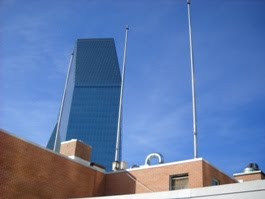Dr. James Baker is the CEO of Metrocare Services, the largest provider of mental health services in the Dallas area (here’s its website:
http://www.metrocareservices.org/). He must have been following this series of blogs, because I got a question from him yesterday. That question led to the exchange below, which I am publishing with his permission:

Are you going to respond to the below comment from below Kim Horner's article online?
-j
"DO THE MATH: on trying to convert a hotel into an estimated two hundred rooms that are 350 sq foot boxes to house these folks: At $25,000,000 of a 'proposed' budget - that’s about $125,000 per apartment, and on a ‘leasable square foot basis’ (a common metric many developers use to budget multifamily projects), that weighs in at about $330 per foot of living space! CAN YOU SAY the 'W’, or the Belagio in Vegas? And again, you and I are paying for most of it in taxes. Compare this ridiculously expensive number to Class-A market rate apartments in upscale parts of Dallas which are usually built for a total of $120-150 per leasable square foot - For about a third. Something smells funny here."My response:
I don't know, because it isn't an apples to apples comparison and you really have to be a geek to understand why. There are actually 246 units and the average size is slightly larger, and there is a whole bunch of extra space for offices and amenities. High-rise construction and the dirt under it are more expensive. Tax credit deals have a whole bunch of extra costs that you can't avoid--consultants and attorneys mostly. Then you have to have a security system well beyond what any garden apartments have.
Also, the cost of bathrooms and kitchens is the highest per square foot cost in an apartment and you still need at least one of each whether the apartment is 1200 or 350 sq. ft. In addition, you have to build PSH to a very high standard of durability and furnish the units as well. Those add more costs. In the end you'll find that building small PSH units is only maybe 20% cheaper than building other units that are twice as large.
But as a developer of PSH, I don't really care about the cost per square foot, but the cost per unit--can you imagine the screams if we built big ritzy units for homeless persons (I may do that someday, though, just for the fun of irritating people like the one that wrote the comment). It's more practical to build smaller units that are more per square foot but less per unit.
In the real world, you can build a nice 750 sq. ft. class B apartment unit for about $120,000 in an area near downtown. You can build a 350 sq. ft. PSH for $100,000. Big square foot difference, but so what?
The even larger problem, though, is that PSH units don't make any money. So how are you going to finance them if you don't use tax credits? You can't carry any debt. So you end up paying the overhead for tax credit units to avoid debt.
In Seattle, the PSH units they are building (which aren't any larger than ours) cost $250,000 to $300,000 per unit. Both the Hamiltons and I can bring PSH units in at about $100,000 per unit. I don't know if someone else could do better, but I doubt it.
If I thought anybody would really listen, then I might sit down and work this all out with references and everything. But it's a lot of work and I don't think anybody is really listening. I'll think about it.
Dr. Baker:
No, I think your point is well taken: that nobody is listening at that level.
[I can’t resist adding a postscript. This is a common problem in dealing with complicated public policy issues. I can explain why a PSH unit costs what it does; why they are built the way that they are; and why those of us working on ending homelessness approach the problem as we do—but it’s not a conversation that fits into an Elevator Speech and doesn’t even really lend itself to a blog post. If you really want to understand, then we’d need to sit down for an afternoon and go over cost estimates, review the spreadsheets we’ve developed, know the relative costs and advantages of various financing strategies and understand the varying predilections of the public and private foundations that support our work.
It would be a lot of work and it’s only interesting to numbers geeks like me. You very likely would lose interest and I don’t have time to make the explanations to very many people.
Criticism is easy; progress is hard. If you think you can do better, then I would welcome you with open arms into the effort to house the homeless. If you think we are making a fortune doing this work, then come look at our offices, or review the public information about us on the internet.
All of us, myself, Dr. Baker, my staff, his staff, everyone involved in the effort, do this work not because it’s easy, not because it makes us popular, not for the money, but because we feel we have to do it. It’s a duty we owe to our fellow Americans, our fellow human beings and to the image of God within them.]
 Sharon Tillis enters the CityWalk building for the first time as a resident, as leasing consultants Arnetta Motley and Robin Loving look on.
Sharon Tillis enters the CityWalk building for the first time as a resident, as leasing consultants Arnetta Motley and Robin Loving look on. Residents Martesha Cox, Sharon Tillis and A. Jarita Sadler get ready to go to their brand new, fully furnished apartments at CityWalk.
Residents Martesha Cox, Sharon Tillis and A. Jarita Sadler get ready to go to their brand new, fully furnished apartments at CityWalk. Martesha Cox receives the keys to her apartment from CityWalk business manager CJ Allen.
Martesha Cox receives the keys to her apartment from CityWalk business manager CJ Allen.






.jpg)



